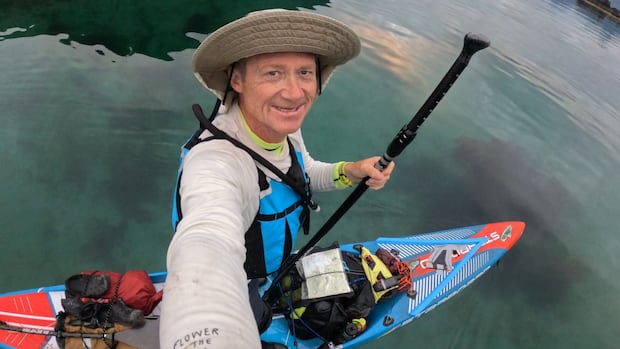“Did you kill Lilly and Jack?”
That was the first question Daniel Martell says he was asked during a polygraph test in the case of two missing Nova Scotia children.
“I was extremely nervous,” said Martell, the stepfather of Lilly and Jack Sullivan, who vanished nearly seven weeks ago.
“It’s like your stress level is just astronomically through the roof and your body doesn’t know what to do because it’s not every day the way you’re hooked up to machines in an interrogation room where someone asks you questions like that.”
Six weeks after two children went missing in Nova Scotia, Lilly and Jack Sullivan’s stepfather says he passed a police polygraph related to their disappearance. He spoke with the CBC’s Kayla Hounsell.
Martell had offered to take a polygraph test early in the investigation, realizing investigators were likely looking his way in the mysterious disappearance of Lilly, 6, and Jack, 4.
On the morning of May 2, police received a 911 call reporting they had wandered away from their home in Lansdowne Station, a sparsely populated and heavily wooded area about 140 kilometres northeast of Halifax.
The disappearance sparked extensive searches that have so far turned up little evidence, as nearly a dozen RCMP units try to piece together what happened to the young siblings.
Meanwhile, those closest to the children are revealing new details about a case that has captivated people across the world.
Martell said he’s gone above and beyond to help police with the investigation, encouraging them to search his family’s property, offering up his cellphone and banking information and asking for a polygraph test.
“The stepfather is always a prime suspect right off the beginning,” said Martell in a recent interview.
About three weeks ago, he sat in a large chair and had sensory pads placed under his forearms, buttocks and feet as part of a polygraph test.
He said all the questions were presumptive that the children are no longer alive, such as: “Are you an accessory to the murder of Lilly and Jack?”
None of the questions assumed the children were taken, he said.
In Canada, polygraph tests are used as an investigative tool and are not admissible in court.
Martell was informed of his results immediately after. He said the investigator told him: “You did a good job. You passed.”

The stepfather is one of 54 people who have been formally interviewed as part of the investigation. Some have received polygraph tests, although RCMP will not confirm how many.
The children’s paternal grandmother, Belynda Gray, has confirmed she was interviewed by police, as well as her son Cody Sullivan. Gray told CBC News they were not asked to participate in polygraph tests.
On the first day of the search, emergency responders speaking over a non-encrypted radio channel mention a canine unit being dispatched to a blanket.
“Families brought us to a location there not far away that there’s a piece of a blanket which the mother says she believes belongs to her daughter, just off the road here,” an official said over the radio.
Martell confirmed it was a piece of Lilly’s blanket.
“There is more evidence than what the public knows, but I can’t elaborate on any of that,” said Martell.
He did say it was found on Lansdowne Road near the location of a child-sized bootprint that was discovered around the same time by searchers in the area of a pipeline trail, just over a kilometre from the children’s home.
RCMP refused to answer questions about the blanket, however the force did confirm the bootprint was believed to be child-sized.
Asked if anything of significance has been uncovered in the course of the investigation, RCMP Cpl. Guillaume Tremblay said there is no evidence to suggest the children were abducted.
He also repeated what the Mounties have said all along, that every missing persons investigation is considered suspicious until they have reason to believe otherwise.
“Investigators have access to all the resources and all the tools that the RCMP can offer, and even outside the RCMP we have other organizations that are engaged with this investigation,” said Tremblay, referring to the National Centre for Missing Persons and the Canadian Centre for Child Protection.
More than six weeks after two young children disappeared in rural Nova Scotia, police are saying very little. CBC’s Kayla Hounsell speaks to family members, the RCMP and search crew members about what we know about the case so far.
Tremblay said they have received more than 500 tips from the public.
“Whether it’s a tip that indicates that there could be something that happened elsewhere in the province, elsewhere in the country, we have to follow up on those investigative tips to rule them out. And to this date we haven’t had any confirmed sightings,” he said.
The last time the children were seen was the day before they went missing, when they were caught on surveillance footage with Martell, Malehya Brooks-Murray, who is the children’s mother, and their one-year-old daughter, Meadow.
Martell said the footage was from a store near Highland Square Mall in New Glasgow, N.S.
“The investigators don’t see me as part of the disappearance,” he said. “I know I have nothing to do with any of it.”

Amy Hansen was part of a team of search and rescue officials that spent 12,000 hours in the thick woods of Lansdowne Station, climbing over and under trees downed during a post-tropical storm in 2022.
Hansen said the time and effort that’s been put into this case is “pretty much unheard of in this province,” and is by far the biggest search she’s been involved in during her 22 years in search and rescue.
She said searchers weren’t just looking for the children, but also clues.
“Clue-sensitive is what we call it. They’re clue finders,” said Hansen, who was the search manager for 10 operational search periods.
“We’re looking for all the evidence of them going through the area.”
Conditions were extremely difficult. Hansen describes teams being close enough that they could touch fingertips, but they couldn’t actually see each other through the thick brush.
Despite the lack of evidence, Hansen still believes the children are in the woods.
“They’re small. They’d be hiding. They would have crawled underneath something probably when they got tired. They could have gone further than what we searched,” she said.
“There’s all kinds of scenarios unfortunately.”
Martell said he’d like to see cadaver dogs — which are trained to pick up the scent of human remains — brought in to search the woods.
RCMP confirmed in a statement that cadaver dogs have not been deployed as part of the investigation.
“Any searches involving the dog will be based on information gathered through the ongoing investigation,” the statement said.
Hansen said the case has taken a toll on volunteers.
“There were members that couldn’t bring themselves to call the names,” she said.
“They just want to find the kids and bring them home, so they’re more than willing to keep coming back and keep searching. Unfortunately, at this point, unless something comes up, we’re probably not going to be back.”







